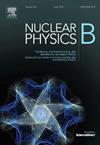基于Durgapal-Lake度量和精华暗能量的Rastall参数对各向异性恒星结构的影响
IF 2.8
3区 物理与天体物理
Q2 PHYSICS, PARTICLES & FIELDS
引用次数: 0
摘要
为了加深我们对各向异性致密物体的理解,本研究揭示了一个以拉斯托尔引力理论为基础的创新理论框架。通过合并Durgapal-IV解和Lake解的Durgapal-Lake (DL)度量函数,我们结合了典型暗能量来深入研究恒星模型的性质。借助观测到的特定物体的半径和质量,通过匹配条件导出DL分析中的未定义参数。我们通过分析致密体物理属性的图形表示对所选函数的有效性进行了全面评估,重点是Rastall参数的具体值。我们的结果表明,所考虑的恒星结构表现出与所提出的模型一致的稳定特征。此外,我们在广义相对论的框架内研究了致密恒星的行为,特别是在零拉斯托参数下,促进了两种理论模型的比较分析。本文章由计算机程序翻译,如有差异,请以英文原文为准。
Impact of Rastall parameter on anisotropic stellar structures using Durgapal-Lake metrics and quintessence dark energy
To deepen our understanding of anisotropic compact objects, this study unveils an innovative theoretical framework grounded in Rastall's theory of gravitation. By employing the Durgapal-Lake () metric functions, which amalgamate the solutions of Durgapal-IV and Lake, we incorporate quintessence dark energy to thoroughly investigate the properties of stellar models. With the help of observed radii and masses of certain specific objects, the undefined parameters in ansatz are derived through matching conditions. We undertake a comprehensive evaluation of the validity of the selected functions through graphical representations that analyze physical attributes of dense bodies, with a focus on specific values of the Rastall parameter. Our results indicate that the considered stellar configurations exhibit stable characteristics consistent with the presented model. Additionally, we investigate the behavior of compact stars within the framework of general relativity, specifically for a null Rastall parameter, facilitating a comparative analysis of both theoretical models.
求助全文
通过发布文献求助,成功后即可免费获取论文全文。
去求助
来源期刊

Nuclear Physics B
物理-物理:粒子与场物理
CiteScore
5.50
自引率
7.10%
发文量
302
审稿时长
1 months
期刊介绍:
Nuclear Physics B focuses on the domain of high energy physics, quantum field theory, statistical systems, and mathematical physics, and includes four main sections: high energy physics - phenomenology, high energy physics - theory, high energy physics - experiment, and quantum field theory, statistical systems, and mathematical physics. The emphasis is on original research papers (Frontiers Articles or Full Length Articles), but Review Articles are also welcome.
 求助内容:
求助内容: 应助结果提醒方式:
应助结果提醒方式:


